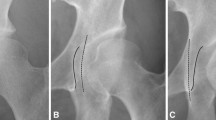Abstract
A study has been performed to evaluate whether one or several levels are needed with computed tomography (CT) study to provide sufficient information regarding anteversion and acetabular support to the femoral head. A total of 23 hips in 14 adults with uni- or bilateral congenital hip dysplasia (center-edge angle less than 20°) were assessed by obtaining 5-mm contiguous CT slices and performing acetabular measurements at four levels. Both anterior and posterior acetabular supports as quantified by the anterior and posterior acetabular sector angles were significantly lower than normal at all levels. The sector angles increased in the proximal cuts, whereas the acetabular anteversion increased caudally. Because no important additional information was gained by measuring at different levels, we conclude that CT study at one level is sufficient for acetabular measurements and suggest that the slice through the center of the femoral head is the most appropriate one.
Similar content being viewed by others
References
Anda S, Svenningsen S, Dale LG, Benum P (1986) The acetabular sector angle of the adult hip determined by computed tomography. Acta Radiol 27:443
Anda S, Terjesen T, Kvistad KA, Svenningsen S (1991) Acetabular angles and femoral anteversion in dysplastic hips in adults: CT investigation. J Comput Assist Tomogr 15:115
Bombelli R, Santore RF, Poss R (1983) Mechanics of the normal and osteoarthritic hip. Clin Orthop 182:69
Dubowitz B, Barmeir E, Stein, M, Roffman M (1981) Normal axial anatomy of the hip as demonstrated by computed tomography. Clin Radiol 32:663
Edelson JG, Hirsch M, Weinberg H, Attar D, Barmeir E (1984) Congenital dislocation of the hip and computerised axial tomography. J Bone Joint Surg [Br] 66:472
Gugenheim JJ, Gerson LP, Sadler C, Tullos HS (1982) Pathologic morphology of the acetabulum in paralytic and congenital hip instability. J Pediatr Orthop 2:397
Jentschura G (1951) Über die praktische Anwendung der Methode Wibergs für die Beurteilung der kongenitalen Dysplasie des Hüftgelenkes beim Erwachsenen. Z Orthop 80:34
Johnston CE, Wenger DR, Roberts JM, Burke SW, Roach JW (1986) Acetabular coverage: three-dimensional anatomy and radiography evaluation. J Pediatr Orthop 6:548
Lafferty CM, Sartoris DJ, Tyson R, Resnick D, Kursunoglu S, Pate D, Sunderland D (1986) Acetabular alterations in untreated congenital dysplasia of the hip: computed tomography with multiplanar reformation and three-dimensional analysis. J Comput Assist Tomogr 10:84
Lang P, Steiger P, Genant HK, Chafetz N, Lindquist T, Skinner S, Moore S (1988) Three-dimensional CT and MR imaging in congenital dislocation of the hip: clinical and technical considerations. J Comput Assist Tomogr 12:459
Ogata S, Moriya H, Tsuchiya K, Akita T, Kamegaya M, Someya M (1990) Acetabular cover in congenital dislocation of the hip. J Bone Joint Surg [Br] 72:190
Peterson HA, Klassen RA, McLeod RA, Hoffman A (1981) The use of computerised tomography in dislocation of the hip and femoral neck anteversion in children. J Bone Joint Surg [Br] 63:198
Rab GT (1981) Containment of the hip: a theoretical comparison of osteotomies. Clin Orthop 154:191
Rab GT (1981) Preoperative roentgenographic evaluation for osteotomies about the hip in children. J Bone Joint Surg [Am] 63:306
Rális Z, McKibbin B (1973) Changes in shape of the human hip joint during its development and their relation to its stability. J Bone Joint Surg [Br] 55:780
Reikerås O, Bjerkreim I, Kolbenstvedt A (1982) Anteversion of the acetabulum in patients with idiopathic increased anteversion of the femoral neck. Acta Orthop Scand 53:847
Reimers J, Bialik V (1981) Influence of femoral rotation on the radiological coverage of the femoral head in children. Pediatr Radiol 10:215
Salter RB, Hansson G, Thompson GH (1984) Sailer's innominate osteotomy in the management of residual congenital subluxation of the hip in young adults. Clin Orthop 182:53
Severin E (1941) Congenital dislocation of the hip joint. Acta Chir Scand 84 [Suppl 63]:1
Terver S, Dillingham M, Parker B, Bjorke A, Bleck EE, Levai JP, Teinturier P, Viallet JF (1982) Étude de l'orientation réelle du cotyle grâce au tomodensitomètre axial ou scanner. J Radiol 63:167
Visser JD, Jonkers A, Hillen B (1982) Hip joint measurements with computerized tomography. J Pediatr Orthop 2:143
Wiberg G (1953) Shelf operation in congenital dysplasia of the acetabulum and in subluxation and dislocation of the hip. J Bone Joint Surg [Am] 35:65
Author information
Authors and Affiliations
Rights and permissions
About this article
Cite this article
Anda, S., Terjesen, T. & Kvistad, K.A. Computed tomography measurements of the acetabulum in adult dysplastic hips: which level is appropriate?. Skeletal Radiol. 20, 267–271 (1991). https://doi.org/10.1007/BF02341662
Issue Date:
DOI: https://doi.org/10.1007/BF02341662




